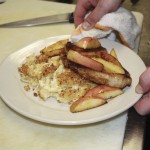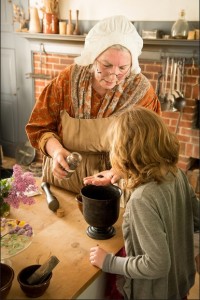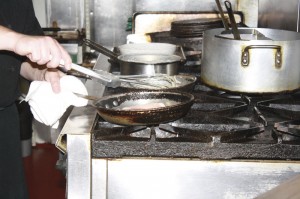St. ALBANS — Local restaurants are taking part in the St. Albans Raid anniversary festivities by preparing Civil War era themed dishes during Northern Hospitality Weekend, Sept. 18 through the 21.
Participating eateries thus far include: Jeff’s Restaurant, My-T-Fine II, Mimmo’s, Round Table Bakery & Café, Green Mountain Café, Pie in the Sky, 84 Main Sports Grill, and One Federal.
As an example, Jeff’s restaurant will serve a raid-themed macaroni and cheese dish with pork chops. The recipe used, which chef Jeremy Howe found in a Civil War magazine geared towards women called Godey’s Lady Book, simplifies current mac and cheese.
“It’s a super easy one pot meal. I’ve made many a mac and cheese and it never occurred to me to cook the noodles in the milk. It’s really, really simple. Noodles take 15 minutes to cook, 20 to 30 in the oven. Pork chops are thin, pan fried, so easy,” he said.
The women’s magazine Godey’s Lady Book was sold to women in both the North and the South, so regardless of what side the war they were on, all women made the same clothes and used the same recipes from the magazine, Howe noted.
 Jeff’s “Civil War Mac & Cheese” is so simple, Chef Jeremy said, anyone could make it.
Jeff’s “Civil War Mac & Cheese” is so simple, Chef Jeremy said, anyone could make it.
To cook: Preheat oven to 400 degrees. Put the milk in a saucepan and once steamy, add noodles. Let milk come to a boil, and then reduce heat to a simmer. Cook for 15 minutes. Meanwhile, melt cheese in a separate pan with butter in order to make extra creamy. When noodles are ready, combine melted cheese with macaroni and place into baking dish. Sprinkle with breadcrumbs and cook for 20 to 30 minutes in the oven.
“It’s amazing I never thought to do this,” Jeremy said. “I thought, cheddar cheese is so greasy, and in recipe it says to melt butter and I thought this is going to be weird, and greasy and strange, but as you whisk it, it comes together nice and smooth.”
Jeremy is also adding pork chops to the Civil War inspired dish. For pork chops, put oil in pan, wait for it to get hot, then add salt and pepper. Fry on both sides, cut apples and throw into pan.
Like great-great-great grandma used to make
19th century food expert lays out Civil War menu

Pat Mead, the Lead Interpreter of Historic Foodways at the Genesee Country Village & Museum in Mumford, N.Y., dressed in period clothing, teaches about food of the 19th Century. – Photo submitted by Pat Mead
When preparing food during the Civil War era, simplicity was key. Pat Mead, lead interpreter for Historic Foodways at the Genesee Country Village and Museum in Mumford, N.Y., is an expert on food dishes of the 19th century, as she works at a 19th century living history village and museum.
According to Mead, during the Civil War era, people ate seasonally. In the fall months, cabbage was a popular food. One better-known Irish cabbage-based dish, called “Bubble and Squeak,” was comprised of cabbage, onions and potatoes. To make this, the cook would slice up and fry onions, then add cooked potatoes and cabbage and cook for 10 minutes. Sometimes fried bacon was also added to the meal.
“Bubble and Squeak” was considered a meal for the “lower class,” according to Mead, as available food dishes during this period depended heavily on economic standing. This cabbage dish got its name from the squeaky sound the cabbage makes.
From September to April, oysters were widely available and became one of the first canned foods. When oysters were in season, they were a popular food among all classes, and oyster recipes were abundant. Coconut was also newly available, and it is known that Abraham Lincoln’s favorite dessert was coconut cake, said Mead.
Macaroni and cheese was just as popular then as it is today, Mead said, and it came about after Jefferson’s presidency. Pipe macaroni became available, and before cheese was manufactured, people grated their own.
Anything with pork was popular, although access to meat depended on time of year and how wealthy a person was. If you lived in the city and were wealthy, meat was available anytime. If you lived on the countryside, meat was only available during December and January, and had to be salted or smoked.
From May to July, when chickens were laying well, eggs were used in many dishes. Unwashed eggs could be preserved for up to three months without refrigeration, and sometimes people would cover the shell with butter or lard as a way to preserve. Eggs were used as the main course of a meal, and sprinkled with herbs and spices or accompanied by sausage.
Common fare
Breakfast foods during the Civil War were nothing like we consider traditional breakfast today, Mead said. For breakfast, people would usually just eat leftovers from the night before.
Often times, after baking all day, the oven was still hot and people would cook beans with molasses and salt and leave them in over night, so they would be ready by breakfast time the next day. Pie was also a common breakfast food, but the “pie” they ate back then can be compared to modern day Pop-Tarts.
For desserts, people loved breads, cakes, teacakes and cookies. For special events, such as weddings, fruitcakes were typically used as a sign of wealth. Fruitcakes were made with dried fruit such as raisins, cherries and citrons and were very dense.
One cake from the era that is popular at Mead’s museum today is the 1 2 3 4 cake. It was also known as a cup cake, because it used one cup of butter, two cups of sugar, three cups of flour, and four eggs. Today it is known as a pound cake. After 1850, flavors like vanilla and rosewater came out, which could be added to the cake for a better taste. Spices were used to make spice cakes, and lemon extract was popular at the time as well. To serve cakes, people would add fruit or icing to the to the top, or sometimes serve without anything else. Apples were enormously popular, Mead said, and could be obtained year round to make desserts like apple pie.
A common method of storing food during this time was pickling, Mead said. Not just cucumber pickles, but pickled apples, fruits, and veggies. Pickling meant putting any kind of food in vinegar with salt and sugar. At Mead’s museum they still pickle foods in the old-fashioned way, and she said the results taste “very good.” Before canning came into practice, just after 1850, people had to smoke, salt, dry and pickle foods.
Condiments
Condiments back in this era were very different than the kinds found in stores today. Ketchup, for instance, was hardly ever made with tomatoes. Instead there were walnut and grape ketchups, which could be added to stews and soups. Ketchup is described as a sauce that has vinegar, sugar, fruit and a fish sauce, Mead explained.
Some historians believe people used sauces to cover up “bad” meat, but Mead said she believes condiments were simply used for added flavor, and there was not as much bad meat as some may think. Condiments could also stand alone on a dinner table, and pickled beans, corn relish and sour croute were often eaten all by themselves.
Drink
One popular drink during this period was “Shrubs.” A shrub contains leftover fruits such as cherries, raspberries and strawberries, soaked in vinegar and then left to sit for a few days. Once the fruit has soaked long enough, it was mashed and put through a sieve to measure the vinegar and fruit juice. After adding sugar and ice, the drink was bottled and ready to be consumed. Shrubs were not refrigerated.
At the museum where Mead works, she said they provide samples of shrubs for visitors.
“Ninety eight percent of people like them,” she said. “Sometimes you’ll have a kid that doesn’t want to try it, but people really do love them. They are very tasty,” Mead said.
A “Switchel,” is another period drink, made of vinegar, ginger, molasses and honey. This is considered a 19th century version of what we know as Gatorade. “It replenished your fluids,” Mead said.
Story & Photos By NATALIE HANDY, Messenger Staff
Much more is available about the Genesee Country Village and Museum on its website (https://www.gcv.org/). The Messenger appreciates its help in making this report possible.




